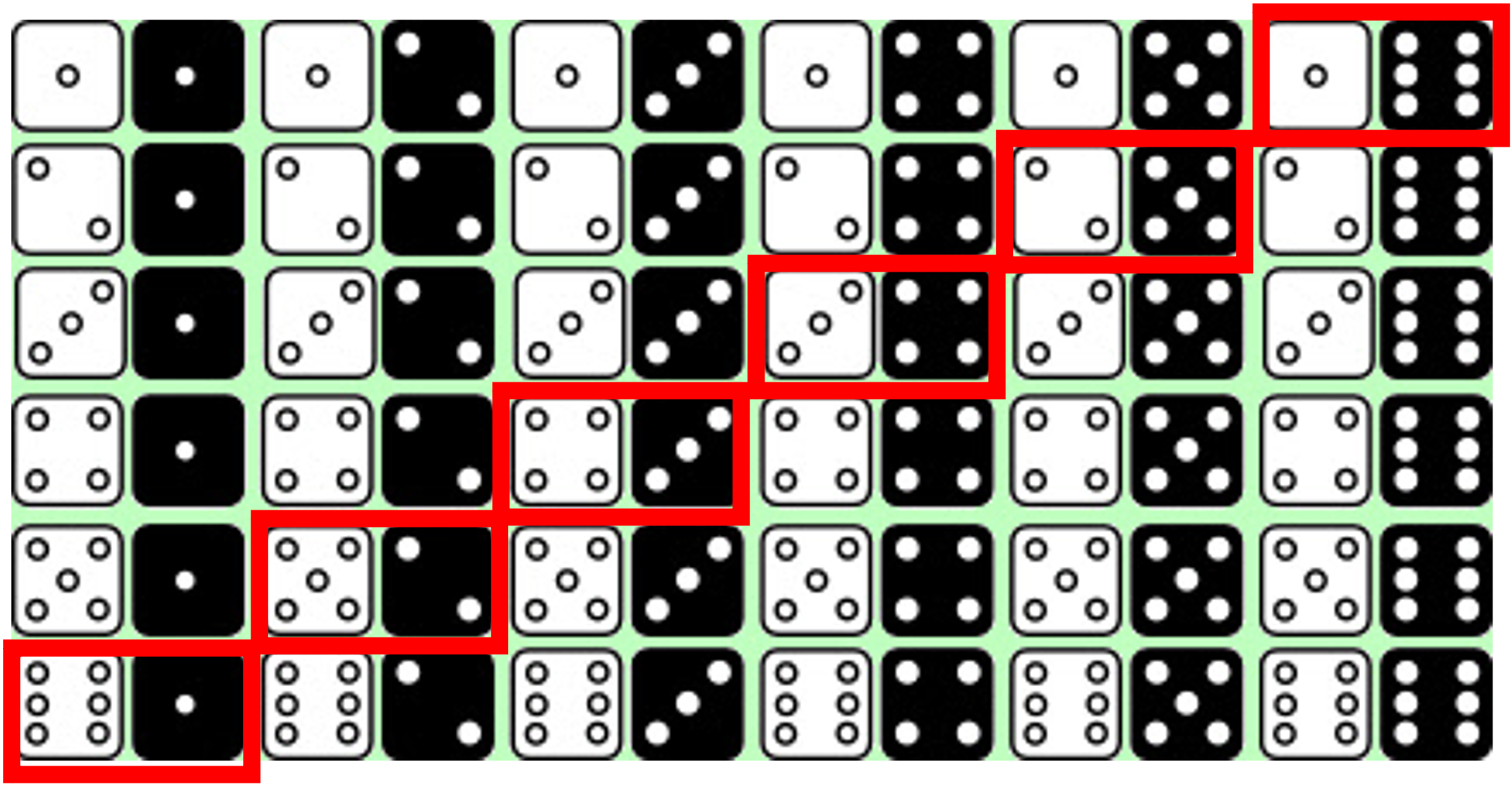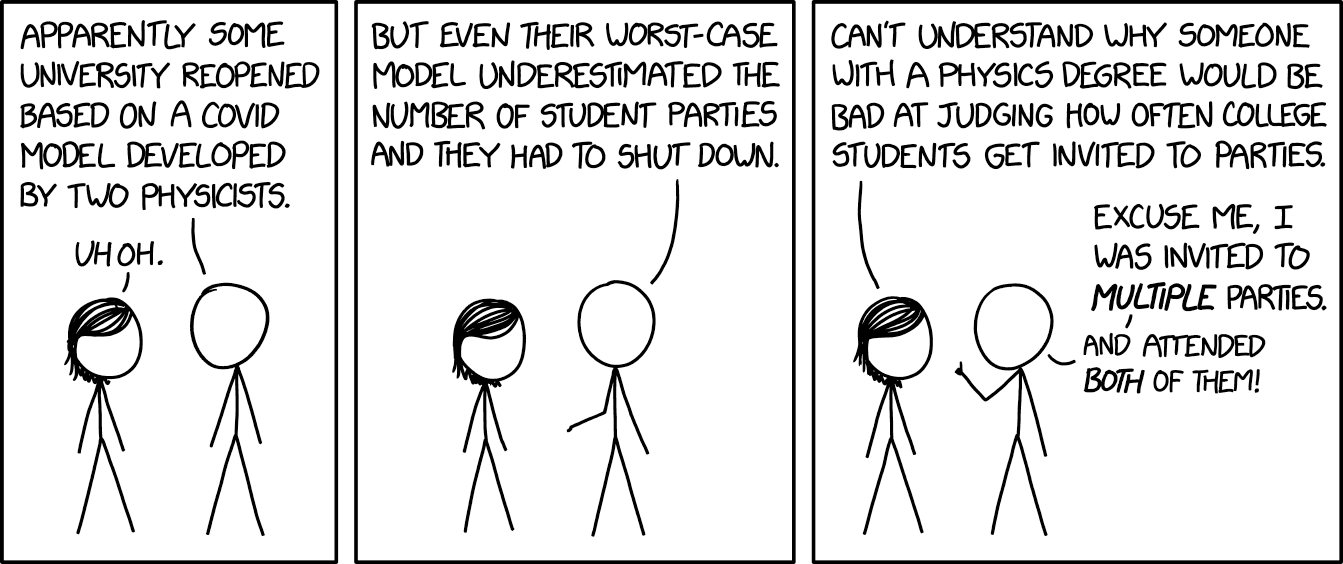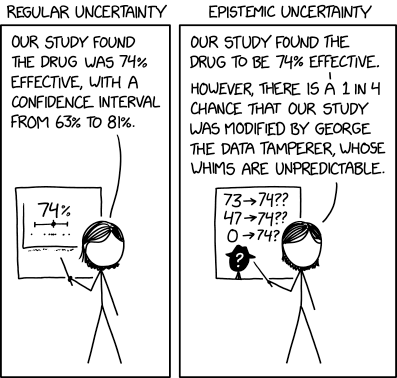class: center, middle .title[Simulating Systems] <br> .subtitle[BEE 4750/5750] <br> .subtitle[Environmental Systems Analysis, Fall 2022] <hr> .author[Vivek Srikrishnan] <br> .date[August 29, 2022] --- name: toc class: left # Outline <hr> 1. Questions? 2. Simulating Systems 3. Uncertainty and Probability --- name: poll-answer layout: true class: left # Poll <hr> .left-column[{{content}} URL: [https://pollev.com/vsrikrish](https://pollev.com/vsrikrish) Text: **VSRIKRISH** to 22333, then message] .right-column[.center[]] --- name: questions template: poll-answer ***Any questions?*** --- name: reasons class: left layout: false # Some Reasons To Simulate With Models <hr> * System involves complex, nonlinear dynamics that may not be analytically tractable. * Setting up and running a real-world experiment is not possible * Need to understand range of system performance across rarely-seen conditions. --- class: left # Simulating Dice Rolls <hr> A model doesn't have to be particularly "complex" for it to be worth simulating: sometimes there are just a lot of combinations, and it would be tedious to solve the problem analytically. Let's look at a classic (if cliched) example: **what is the probability of rolling two dice and getting a count of 7?** --- # Simulating Dice Rolls <hr> **What is the probability of rolling two dice and getting a count of 7?** .left-column[ .cite[Modified from [West Yorkshire Backgammon](http://westyorkshirebackgammon.co.uk/How%20to%20part%203.html)] ] -- .right-column[Sample Space (total number of combinations): 36, each with probability 1/36 Events summing to 7: 6 **So the probability is 6/36=1/6.**] --- class: left # A More Involved Dice Example <hr> Now: **what is the probability of rolling 4 dice for a total of 19?** -- We could solve this analytically as well, but it's tedious. Instead, let's solve this computationally. --- class: left # A More Involved Dice Example <hr> **What is the probability of rolling 4 dice for a total of 19?** To answer this question, we have two options: -- 1. We could enumerate all possibilities of combinations of 4 dice (*~1300*), like before, but use a computer to do it more quickly. -- 2. We can simulate lots of individual rolls of 4 dice and keep a running tally of the frequency of 19s. --- class: left # A More Involved Dice Example <hr> **What is the probability of rolling 4 dice for a total of 19?** ```julia using Random, Distributions Random.seed!(1) # set seed # this function rolls several dice repeatedly and returns the sums of each trial function dice_roll_repeated(n_trials, n_dice) dice_dist = DiscreteUniform(1, 6) roll_results = zeros(n_trials) for i=1:n_trials roll_results[i] = sum(rand(dice_dist, n_dice)) end return roll_results end ``` --- class: left # A More Involved Dice Example <hr> **What is the probability of rolling 4 dice for a total of 19?** ```julia # roll four dice 10000 times rolls = dice_roll_repeated(10000, 4) # calculate probability of 19 sum(rolls .== 19) / length(rolls) ``` ``` 0.045 ``` -- By comparison, the true value is 0.0432. Is that difference meaningful? --- class: left # A More Involved Dice Example <hr> **How does this estimate vary as we add more simulated rolls?** ```julia # initialize storage for frequencies by sample length avg_freq = zeros(length(rolls)) # compute average frequencies of 19 avg_freq[1] = (rolls[1] == 19) count = 1 for i=2:length(rolls) avg_freq[i] = (avg_freq[i-1] * (i-1) + (rolls[i] == 19)) / i end ``` --- class: left # A More Involved Dice Example <hr> **How does this estimate vary as we add more simulated rolls?** .left-column[ ```julia using Plots # plot running average frequencies scatter(avg_freq, markershape=:xcross, markersize=1, grid=:false, label="frequency of 19s", legend=:bottom) # plot the true value for comparison hline!([0.0432], color="red", label="true value") ``` ] .right-column[.center[]] --- class: left # A More Involved Dice Example <hr> This use of stochastic simulation to solve a deterministic problem is an example of *Monte Carlo estimation*. We'll return to this later. -- **Note**: For this problem, Monte Carlo simulation actually took more runs to get a "reliable" estimate. But it may scale better as the number of uncertainties increases (6 dice: *~46,000 combinations*). --- template: reasons layout: false --- class: left layout: true # Multiple Objectives and Tradeoffs <hr> Simulation also facilitates *exploratory* analyses of multiple outcomes of interest. For example: {{content}} --- **Reservoir management** involves tradeoffs between water supply, hydropower potential, flood risk, and streamflow. --- **Electric power systems** can involve tradeoffs between reliability, emissions, and other materials flow (for batteries) --- **Climate risk management** involves...lots of tradeoffs! Mitigation costs, warming risk, and more specific cross-sectoral tradeoffs depending on the mitigation pathway. --- class: left layout: false # Reminder: "All Models Are Wrong, But Some Are Useful" <hr> .center[] .cite[Source: [https://xkcd.com/2355](https://xkcd.com/2355)] --- class: left # Reminder: "All Models Are Wrong, But Some Are Useful" <hr> .left-column[*Every* systems model simplifies or neglects certain aspects of the system! It's essential to use domain knowledge to understand when these simplifications are appropriate and what the implications might be.] .right-column[] --- class: left # Uncertainty and Systems Modeling <hr> .left-column[Deterministic systems models can be subject to uncertainties due to the separation between the "internals" of the system and the "external" environment.] .right-column[] --- class: left layout: true # What Is Uncertainty? <hr> {{content}} --- **Glib Answer**: *A lack of certainty!* -- **More Seriously**: Uncertainty refers to an inability to exactly describe current or future values or states. --- Two (broad) types of uncertainties: * *Aleatory* uncertainty, or uncertainties resulting from randomness; * *Epistemic* uncertainty, or uncertainties resulting from lack of knowledge. --- class: left layout: false # On Epistemic Uncertainty <hr> .center[  <br> .cite[Source: [https://xkcd.com/2440](https://xkcd.com/2440)] ] --- name: probability-def class: left layout: false # Uncertainty and Probability <hr> We often represent uncertainty using *probabilities*. What is probability? --- template: poll-answer ***What is probability?*** --- template: probability-def -- * Long-run frequency of an event (**frequentist**) -- * Degree of belief that a proposition is true (**Bayesian**) -- The frequentist definition concerns what would happen with a large enough number of repeated trials. The Bayesian definition concerns the odds that you should bet on an outcome. --- class: left name: distributions # Probability Distributions # <hr> .left-column[The likelihood of possible values of an unknown quantity are often represented as a probability distribution. One key feature for systems analysis: **tails**! These can represent low-probability but high-impact outcomes (more on this later...)] .right-column[.center[]] --- class: left name: distributions-julia # Working with Distributions in Julia <hr> In Julia, we use [`Distributions.jl`](https://juliastats.org/Distributions.jl/stable/) to work with probability distributions. .left-column[ ```julia using Random, Distributions, Plots Random.seed!(1) # set seed # define a distribution normal_dist = Normal(0, 1) # draw samples normal_samp = rand(normal_dist, 1000) # plot histogram histogram(normal_samp, grid=false, legend=false, ylabel="Count", xlabel="Value", size=(500, 400)) ``` ] .right-column[.center[]] --- name: distributions-julia-2 class: left # Working with Distributions in Julia <hr> We can also plot probability distribution functions (pdfs). .left-column[ ```julia using Distributions, Plots # set grid of x values to evaluate x = range(-10, 10; length = 100) # evaluate pdf over x norm_pdf = pdf.(Normal(0, 2), x) # make plot plot(x, norm_pdf, linecolor=:blue, legend=false, grid=false, xlabel="Value", yticks=false, yaxis=false, size=(500, 400)) ``` ] .right-column[.center[]] --- class: middle, left <hr> # Next Class <hr> * Coding example of systems simulation (**bring laptop to class if possible!**) * How does Monte Carlo work?